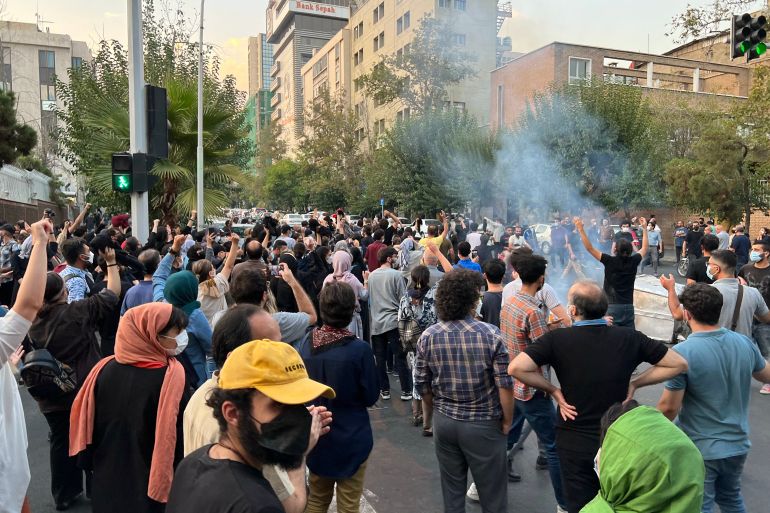Iran confirms first deaths in protests over Mahsa Amini’s death
Iranian officials said foreign actors are influencing the spreading protests over the death of a young woman.

Tehran, Iran – An Iranian governor has confirmed the first fatalities during protests over the death in police custody of a young woman named Mahsa Amini – but the governor has said the three individuals were killed by anti-establishment elements.
Esmail Zarei Kousha, governor of the northwestern Kurdistan province, told reporters on Tuesday that three people died “suspiciously” during “illegal protests” in recent days, according to state-affiliated media.
Keep reading
list of 4 itemsIran denies Mahsa Amini, woman who died in custody, was beaten
Photos: Iranians protest over the death of Mahsa Amini
UN calls for ‘impartial’ investigation into Iranian woman’s death
“Investigations have shown that these people were shot and killed by those working against the establishment and with firearms that are not employed by any tiers of security or law enforcement forces in the province,” he said.
According to the governor, one person died in Divandareh, another was left in a car near a hospital in Saqqez, and a third “suspicious” death is being investigated.
Families must be careful because “anti-revolutionary” groups wish to use Mahsa Amini’s name as a code [rallying call] to advance their own goals, Zarei Kousha said, in a likely reference to a phrase that has been mentioned many times after being written on Amini’s grave: “You won’t die, your name will become a code”.
Twenty-two-year-old Amini was travelling away from her hometown in Saqqez, Kurdistan, and was in Tehran with family last week when she was detained by the so-called morality police for wearing an “improper” hijab.
When in a “guidance centre” later the same day, authorities say, she had a stroke and a heart attack and was transferred to a nearby hospital, where she died several days later.
Her family has explicitly denied claims by Tehran’s police chief earlier this week that she was not beaten, that she had several pre-existing conditions like epilepsy and diabetes, and that she had violated Iran’s mandatory modest-dress rules in effect since shortly after the country’s 1979 Islamic Revolution.
Iranian, foreign nationals arrested
Several days of protests have ensued since Amini’s death on Friday.
They began in her hometown of Saqqez, where she was buried, and spread to several cities in Kurdistan. Amini’s name has been mentioned on Twitter more than five million times.
In addition to demonstrations at several universities in the capital, there were protests in downtown Tehran on Monday and Tuesday, which were dispersed by security forces and tear gas, according to state media and videos widely circulated on social media.
It is unclear how many individuals have been arrested, but Tehran’s Governor Mohsen Mansouri announced on Tuesday that foreign nationals were also among those arrested.
“According to exact reports by responsible entities, in Tehran’s recent issues, the footprints of intervention by some embassies and foreign services can be clearly seen,” he wrote in a tweet.
“In arrests made last night during Tehran’s gatherings, nationals from three foreign countries were arrested,” he added without elaborating.
Protests have also been reported in other major and smaller cities, including Isfahan, Mashhad and Rasht.
President Ebrahim Raisi, who called Amini’s father earlier this week to promise an investigation is being carried out, left Tehran for New York on Monday to participate in the United Nations General Assembly.
The UN on Tuesday demanded an independent investigation into Amini’s death.